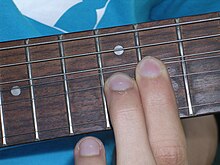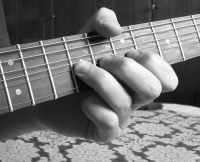Finger vibrato
It can also refer to vibrato on some woodwind instruments, achieved by lowering one or more fingers over one of the uncovered holes in a trill-like manner.Moving the finger, wrist, or arm forward or backward primarily determines the tone.[citation needed] In its pure form, vibrato is usually achieved by twisting the wrist rapidly to bend the note slightly, moving to and from the starting pitch.The slowest of vibratos can be used to imitate a bowed instrument "growing" a note after its initial inception.When a classical guitarist sees the term vibrato written in a score, this is generally the first effect that comes to mind.Examples include Jimmy Page's unaccompanied solo break in Led Zeppelin's "Heartbreaker".When a string is bent, the sound it creates is much smoother than would be otherwise, even using other slurred techniques such as hammer-ons, pull-offs, or finger slides.Some masters of string bending on guitar include David Gilmour, Tony Iommi, Brian May, T-Bone Walker, B.In 1928, Maurice Martenot—inspired by his experience as a cellist—invented the Ondes Martenot, which featured a keyboard that the player could rock back and forth laterally.Some 2010s and 2020s MIDI controllers and synthesizer keyboards have pressure or aftertouch sensors which sense if the player is continuing to press down a key after the initial striking; on some synth module patches (sounds), continued pressure on a key triggers an electronic vibrato effect, in imitation of the expressive vocal, bowed strings, or wind technique of adding vibrato to a held note.



vibratostring instrumentwoodwindclassical guitaristsbassistsClassical guitar techniquewhole stepelectric guitarstring bendingcountrypop musicsemitoneportamentomicrotonalityblue notespinch harmonicssemitonesDavid GilmourAnother Brick In the WallPink FloydThe Wallstring gaugescale lengthtuningquarter tonetempered scalesong keychromatic scalemajor pentatonic scalewhole toneStevie Ray VaughanPeter Greenmachine headJimmy PageLed Zeppelinslurredhammer-onspull-offsslide guitarTony IommiBrian MayT-Bone WalkerB. B. KingEric ClaptonclavichordBebungkeyboard instrumentMaurice MartenotOndes Martenotpressure-sensitiveelectronic keyboardsRodgerstrumpetMIDI controllerssynthesizersynth moduleeffectaccordionBaroque musicBaroque fluterecorderJacques-Martin HotteterreMichel CorretteIrish musicuilleann pipespennywhistleList of ornamentsGlissandoViolin familyViolinElectric violinPochetteFive-string violinViolino piccoloAlexander violinStroh violinVertical violaViola pomposaTenor violinBass violinBaritone violinCello da spallaCelloneElectric celloDouble bassElectric upright bassVioloneOctobassBass barBridgeChinrestEndpinF-holeFingerboardScrollShoulder restSound postTailpieceTuning pegTechniquesBowingBow strokeCol legnoMarteléPortatoSpiccatoTremoloArpeggioHarmonicsDouble stopFingeringFinger substitutionBariolagePizzicatoScordaturaString quartetString trioString quintetString sextetString octetString sectionString orchestraViolin concertoViola concertoCello concertoDouble bass concerto